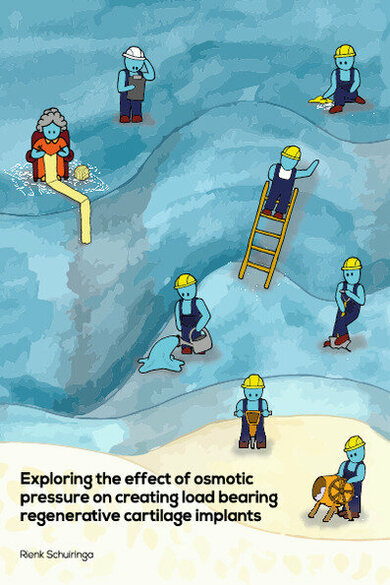HydroSpacers that mimic the loadability of natural cartilage
Rienk Schuiringa defended his thesis at the Department of Biomedical Engineering on September 21.

For his PhD, Rienk Schuiringa focused on better treatment for cartilage defects. These defects cause severe pain and mobility limitations. Current regenerative treatments have shortcomings, such as inability to bear weight, which makes recovery difficult. Schuiringa's research led to the Hydrospacer, which combines regeneration and weight-bearing to improve the lives of patients with cartilage defects and speed their recovery.
Cartilage defects caused by trauma or disease can lead to osteoarthritis if left untreated. Osteoarthritis is a progressive condition that eventually causes bone-on-bone contact, which is painful and limits mobility. Regenerative treatments, while helpful, often result in new tissue that differs from the original, not having the same properties.

HydroSpacer
Hydrogels are often used for regenerative treatments because of their water-attracting properties, which mimic natural cartilage. These hydrogels break down during tissue repair, resulting in the formation of new tissue. However, the main disadvantage of hydrogels is that they are often too soft and cannot support the joint after implantation. Cartilage owes its load-bearing capacity to its specific structure and composition, including negatively charged polysaccharides and collagen fibers that counteract swelling and create osmotic pressure. So with his research, Schuiringa is investigating whether this mechanism can be mimicked with a negatively charged polymer hydrogel and a 3D knitted spacer-fabric, together called HydroSpacer. This spacer-fabric has a unique structure with knitted top and bottom layers and perpendicular fibers between them, creating space for hydrogel injection.
Several methods were used to develop this HydroSpacer. First, swelling hydrogels were combined with a spacer fabric, leading to wearing properties similar to natural cartilage. It was also tested that the HydroSpacer did not cause damage to adjacent cartilage, which is essential for joint implants. The study showed that proper placement of the HydroSpacer is crucial to prevent damage to adjacent tissue.
Cartilage-Collagen
For a successful regenerative implant, the implanted cells must be able to build up cartilage tissue. During tissue culture, it was found that cartilage specific collagen could be formed around the cells in the HydroSpacer, indicating that the HydroSpacer did not impede collagen formation.
In summary, combination of 3D knitted spacer-fabrics and swelling hydrogels results in HydroSpacers that mimic the load-bearing capacity of natural cartilage. Made of biocompatible and biodegradable polymers, these promising regenerative cartilage implants approximate the load bearing properties of natural cartilage, resulting in immediately loadable HydroSpacers, which improves and shortens postoperative recovery.
Investigating the interaction between osmotic pressure, (dynamic) loading, matrix synthesis and the effect of mechanical signals, are the next steps to bring current HydroSpacers closer to clinical application.
Title of PhD thesis: “Exploring the effect of osmotic pressure on creating load bearing regenerative cartilage implants”
Supervisors: Keita Ito and René van Donkelaar